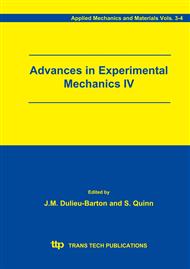p.39
p.47
p.53
p.59
p.65
p.71
p.79
p.85
p.91
In Situ Measurement of Internal Stress in Electroless Plating by Television Holographic Interferometry
Abstract:
Electroless plating can uniformly plate a material on irregular and non-conducting surfaces. Consequently, it has been utilized widely for printed circuit boards in the electronics industry. During the plating process, internal stress is frequently incorporated into the film and this often results in detachment from the substrate. In order to investigate the origins of stress in the films, measurements of film stress are required during the early stages of growth. In this study, TV holography, which can capture holographic images at TV frame rates, was used to sensitively measure the deflection of the cantilever beam during deposition. By substituting the deformation data in Stoney’s equation, it is possible to calculate internal stresses in-situ. The internal stress created by electroless plating from a Cu plating solution on a Be-Cu substrate is discussed. It is assumed that the internal stress is generated in the initial stage in which the plating grains with a thickness of about 0.01µm deposit. This paper shows that the present method can be very useful for in-situ measurement of initial internal stress.
Info:
Periodical:
Pages:
65-70
Citation:
Online since:
August 2006
Authors:
Price:
Сopyright:
© 2005 Trans Tech Publications Ltd. All Rights Reserved
Share:
Citation:


